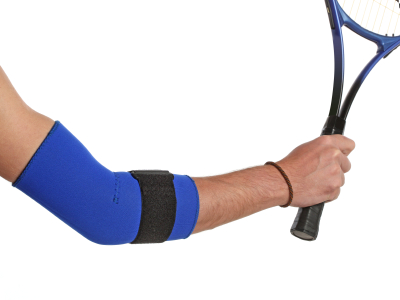This article explains what a Repetitive Strain Injury is and what the common symptoms are. This will be helpful to anyone who thinks they may be suffering from a Repetitive Strain Injury and would like to know how to stop it developing.
Repetetive Strain Injuries (RSI) - Contents
- What is RSI and why is it rising?
- How does RSI develop?
- Are there different types of RSI?
- What tell-tale signs of RSI should I be looking out for?
- Treating RSI
What is RSI and why is it rising?

Repetitive strain injury (RSI) is a term used to describe a broad range of symptoms caused by the repeated movement of a particular part of the body. RSI’s are also known as Work Related Upper Limb Disorders (WRULD), Repetitive Stress Injury and Cumulative Trauma Disorder. It usually affects the upper limb (shoulder, elbow, wrist or hand) and can be caused by any repeated activity including sports and pastimes, but more often it is due to workplace activities, where, of course, we spend a significant amount of our waking hours. Out of the office, recent advances in technology such as smartphones, handheld videogames and even hair-straighteners have led to a new wave of problems with RSI. This demonstrates how even the most entertaining or labour-saving gadget might be causing an RSI which can develop into a chronic problem.
Repetitive Strain Injuries are very common and lead to lengthy periods of pain and time off work. They can be difficult to treat and therapy can be lengthy and expensive.
How does RSI develop?
The biggest problem for both RSI sufferers and their employers is that it almost always tends to start as a minor ache. This is largely because it can affect nerves, muscles, tendons, tendon sheets, bones and joints, one at a time, or in combination.
This slight annoyance is often overlooked and no treatment is sought or given meaning that the tissue irritation and damage therefore progresses. The pain worsens; becoming painful at rest and then at night, affecting sleep. Finally, a slight ache becomes a chronic condition.
When looking for an explanation as to why this occurs, two factors need to be taken into account. The first is that the ability for a tissue to heal is dependent upon its blood supply. The tissues and structures involved in Repetitive Strain Injuries (tendons, tendon sheaths, capsules, ligaments, nerves) generally have very poor blood supplies, therefore they heal very slowly and respond poorly to injury. Secondly, as defined by its name, a Repetitive Strain Injury occurs each time a particular activity is performed. If the use of a computer mouse irritates the tendons around the wrist, it only gets worse when the mouse is used again.
In the early stages of any of these conditions if the tissues were rested fully the problem would settle on its own. However, the healing potential of these tissues is poor (due to the poor blood supply), and it would therefore be necessary to cease the problem activity for an awfully long period of time. Also, once an area is irritated, movements that use the wrist continue to cause damage, even if the exact activity has been stopped. For example, if someone develops irritation of his/her wrist tendons caused by long hours of typing they may stop typing. The symptoms may not settle, however, because many other activities (such as the use of a mouse, telephone, smartphone, even writing) continue to use the same irritated wrist.

Are there different types of RSI?
Broadly speaking there are two RSI conditions:
Type 1 RSI conditions include well-defined syndromes such as shoulder impingement, rotator cuff tendonitis, Carpal Tunnel Syndrome, DeQuervain’s tenosynovitis, Cubital Tunnel Syndrome, olecranon bursitis and ganglion formation. These conditions may be due to, or be made worse by, repetitive tasks. These syndromes may have other symptoms such as swelling, inflammation, nerve compression problems and so forth. These specific orthopaedic problems are often easier to diagnose but this usually happens once the problem has been longstanding.
Type 2 RSI conditions are more complex and unfortunately more difficult to treat. The exact pathology is poorly understood but recent research suggests that the nerves supplying the arm and hand are tethered along their course, leading to deep aching in the forearms and hands, and non-specific pain and symptoms.
What tell-tale signs of RSI should I be looking out for?
There are some key “red flag” symptoms of RSI, which you should look out for:
1. Tingling in the fingers. This can be very common in patients suffering with RSI’s. This is usually due to compression on a nerve such as in Carpal Tunnel syndrome, which is one of the most common problems. Poor wrist posture while typing reduces the space in the carpal tunnel and the repetitive action of typing leads to irritation of the median nerve. This causes the classical symptoms of tingling in the tips of the fingers of the thumb, index finger and middle finger. It can be quite painful, especially at night and if left untreated, can lead to permanent disability.
2. Deep aching pain in the wrist. This occurs especially in people who type a lot. It is often worse at the end of the day. The person often feels stiff in the morning; it loosens up to lunchtime and then aches in the afternoon. This ebb and flow of symptoms disappears as the condition worsens and may develop into constant pain even at rest.
3. Pain when getting dressed – especially with shoulder conditions (impingement syndrome of the rotator cuff tendon). Interestingly, there is an ‘RSI Gender Gap’, with, for example, women often reporting they have to clip their bra on at the front and then slide it round. Men have pain when putting on their jacket – they tend to “put the bad arm in the sleeve first”. Shoulder impingement can start as a catching pain when performing certain movements e.g. lifting an object into an overhead position. As an example of how widespread this situation can be, I have recently seen employees from the aviation, painting and decorating and electrical contractor industries. To put it in the plainest terms, related to their respective professions:
- Aircraft cabin crew have to regularly stow hand luggage in overhead lockers or fit lights.
- Painters and decorators, have to reach up, often for long periods of time, to decorate ceilings, attach covings and ceiling ‘roses’ for example.
- Electricians, frequently work above shoulder height, attaching light fittings.
The list of plasterers, baggage handlers, train and bus workers easily goes on, before we even begin to examine the more traditionally ‘office-based’ roles linked to RSI’s. The point is that it can affect anyone whose working pattern involves lifting and carrying and employers really need to think through how they can minimise or, ideally, prevent such situations.

4. Aching over the outside of the elbow. This is worse when typing or lifting even light objects, such as a cup of tea. Tennis elbow (lateral epicondylitis) often has these symptoms. There is often tenderness (pain when pressing) on the outer tip of the elbow. Other symptoms include a deep aching pain along the back of the forearm when typing or lifting objects. You don’t have to play tennis to develop tennis elbow! It develops because the small muscles in the back of the forearm that help us to lift objects when we pick them up become overloaded.
5. Lumps and bumps - when tissues become irritated or damaged, they become swollen. This is often accompanied by a feeling of warmth and tenderness (painful when you press on it). Certain specific swellings can develop from repetitive strain injuries. Around the wrist (especially the back and thumb side), a ganglion can develop. This is a herniation of the lining of the wrist joint. It can be unsightly, painful and affect many activities. Over the back of the elbow, an olecranon bursa may develop. This may form secondarily to repeated pressure on the tip of the elbow.
Treating RSI
It is necessary to take a comprehensive approach to address all aspects of these painful conditions from accurate diagnosis, physiotherapy, occupational therapy, injection treatments, all the way through to surgery. At my RSI clinic there is a group of highly trained specialists, all working together to treat these conditions. The core philosophy is to draw from the expertise of all the specialists in a multidisciplinary team based approach and the techniques involved are super-specialised.
Why visit a specialised RSI clinic?
I set up a specialised RSI clinic, the only in the UK, because more and more patients were coming to see me with these conditions, following years of treatment by several different types of doctors, with no improvement. Treatments without long-term success can lead to prolonged periods of pain, time off work and significant expense.
Even in difficult cases that had lasted several years, the multidisciplinary team has been able to treat the patients using super-specialised techniques not found at other clinics with success rates of over 90%.
For further information, two free apps are available to download from iTunes: RSI doc and shoulderdoctor.





